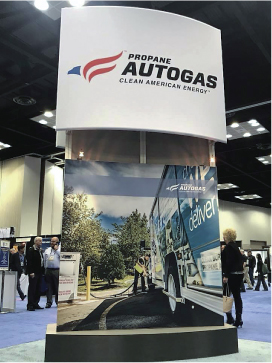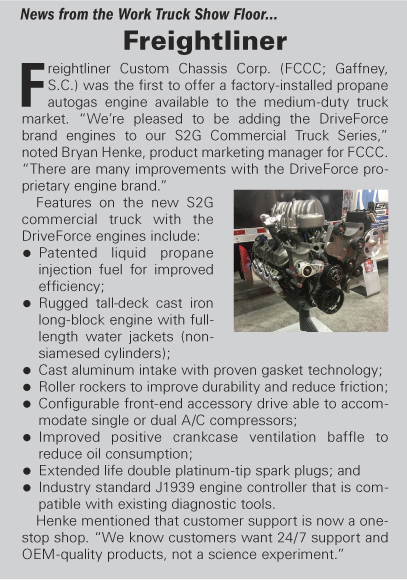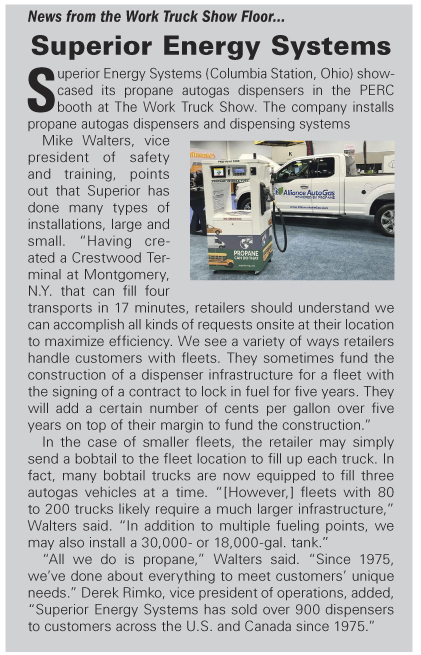Wednesday, April 18, 2018
Brian Donahue of Donahue Gas (Anderson, Ind.) was one of many retail propane marketers to volunteer in the Propane Education & Research Council (PERC) booth during The Work Truck Show in Indianapolis, last March 2018. Occupying the entire Indiana Convention Center, The Work Truck Show draws thousands from all over to see and learn about the latest offerings for work trucks of all types. “I’m happy to come over and help because I want people to know how far propane has come as an alternative fuel for vehicles,” Donahue explained. “We’re a long way from the 1980s, before the days of fuel injection. We’ve gone from the bag phone to the cell phone. It’s important for people to see a large contingent of propane people excited about our product and what it has to offer as a clean, green fuel.” 
Another volunteer in the PERC booth, Rob Little of Ferrellgas (Overland Park, Kan.), is based in Dallas and spends 50% of his time on the road in the western U.S. talking to fleet managers about the benefits of switching to propane. “It’s definitely a longer, more detailed sales process than picking up a typical propane customer account,” Little said. “There are many details involved in moving a fleet to propane, but it is always well worth it.” Little makes numerous technical site visits where decisions are made, including where to place a propane dispenser if the fleet is going to refuel onsite. “There are many details to consider after the decision is made — once it is clear the big savings are real,” he added.
With games and contests to help draw people in, the PERC booth also featured vehicles provided by ROUSH CleanTech (Livonia, Mich.), Alliance AutoGas (Asheville, N.C.), and Power Solutions International (PSI; Wood Dale, Ill.). Others that specialize in propane-powered vehicles and equipment also had booths nearby. “Propane is staking out a larger area of this show in recent years and we’re drawing more of a crowd than in the past,” said Tucker Perkins, president and CEO of PERC. Across the aisle, Alliance AutoGas invited those attending to a happy hour at its booth near the end of the trade show on opening day. The gathering drew a crowd of 50 to 60 people. “They definitely were the loudest group on this side of the trade show,” Perkins commented. “That’s OK. We want people to come and see what the excitement is all about.”
However, PERC wasn’t just inviting showgoers to the trade show exhibits. On the morning the show opened, PERC hosted an educational session called “A Clean Fuel at Best Overall Cost.” A panel of fleet owners shared their experiences with propane’s benefits of low emissions in addition to low total cost of ownership. PERC consultant Greg Zilberfarb began the session noting propane’s overall lower costs when the complete life cycle of the vehicles is considered. “Factoring all costs including maintenance, repairs, labor, wages, fuel hauling, storage, garage, facilities, and refueling infrastructure, propane provides the most savings,” Zilberfarb said. “Propane is nontoxic and is a non-contaminant. It is 36% cleaner than diesel.” Panelists agreed that in addition to the benefits of lower emissions, they were saving approximately $5000 per vehicle per year.
Later that morning, PERC hosted a luncheon event where all stakeholders in the propane autogas market had an opportunity to update staff from Clean Cities Coalitions nationwide, who were invited to the working lunch. Larry Osgood, of Consulting Solutions (Monument, Colo.), began the lunch program saying he wanted everyone to be clear about where propane fits best in the fleet market. Several at the lunch asked for clarification of details they heard the previous day at the daylong Green Truck Summit, which is traditionally held the day before The Work Truck Show.
PERC was one of many co-sponsors of the summit, which had speakers and panels discussing all options for fueling vehicles cost-effectively and with low emissions. It was noted that this year’s Green Truck Summit had less of a focus on propane than in previous years. Several challenged what they saw as excessive hype at this year’s summit about the future of electricity for fueling large trucks. During the PERC and Clean Cities lunch, the propane representatives agreed that some of the expectations for electricity were untested and on the edge of practicality.
Perkins told BPN, “We’ve been studying electric, not just where electric is today, but where we think electricity for powering trucks will be in seven to eight years. Where does the market go?” The PERC CEO noted that Class 3 to 7 vehicles, which range from smaller bakery delivery trucks to school buses, are utilized in fleets where payload and range matter. “Electricity is not a good candidate for range. And we believe propane leaves, and will continue to leave, a smaller carbon footprint than any electric vehicle in California, where emissions are as carefully evaluated as anywhere. We believe propane is, and will continue to be, the greenest fuel that really works.”
Osgood agreed with Perkins on the concern about electric vehicles’ range. “I can see electric being a fit for a small car that only drives short distances. This might be ideal for a person that also drives a car they take longer distances that runs on gas,” Osgood said. “Now, when a large National Park starts talking about running large electric buses from 7 a.m. to 7 p.m., questions arise like where all the electric power will come from.” He also questions how such a park would handle the buses that would need to stop to recharge every four to five hours. “If they need 35 buses to be running each day, will they buy 10 extra buses to be used while other buses charge in the middle of the day?” Another issue is whether the park is willing to put in the high-power lines required to ensure the electricity is where it will likely be needed to charge the buses throughout the park. Osgood has had this discussion with a National Park representative, and said the answers to these questions are just not there right now.
 Osgood sees challenges in other areas as well. “Some electric transit vans would require an 800-pound battery pack. That’s a third of the carrying capacity of the vehicle,” he said. In addition he is often told that companies intend to use only renewable electricity, but he emphasizes that every watt of renewable electricity is in use now. “Every new electric vehicle will represent traditional power.”
Osgood sees challenges in other areas as well. “Some electric transit vans would require an 800-pound battery pack. That’s a third of the carrying capacity of the vehicle,” he said. In addition he is often told that companies intend to use only renewable electricity, but he emphasizes that every watt of renewable electricity is in use now. “Every new electric vehicle will represent traditional power.”
Finally there is a concern about how a vastly expanded number of electric vehicles would refuel. “We currently have about 120,000 service stations in our country with about a million gas pumps. There are about 375 million vehicles, 50 million of which are part of fleets that refuel onsite. That leaves 325 million that use a commercial gas pump, which usually refuels in 3 minutes. An electric vehicle takes a half hour to two hours. A total of 325 vehicles per fuel pump doesn’t work so well with that much more fueling time needed per vehicle,” Osgood said. “While it may work to recharge cars at home, recharging at a workplace presents challenges where there are likely not enough recharging spots. Arranging worksite recharging may take 45 minutes of productivity out of the workday.” He added that the 30 million chargers needed to serve 100 million cars would cost trillions of dollars.
Todd Mouw, president of ROUSH CleanTech, also expressed concerns. “Before electric vehicles become mainstream for commercial applications, there are obstacles that must be addressed so that the fleets get the experience they need to support their business,” he stressed. “The incremental cost of EVs is still extremely high, requiring significant subsidy to show a return on investment. The life cycle of the batteries in these commercial applications is unknown. There aren’t enough charging stations. More OEM involvement is needed.” He acknowledged the current electric grid has limited capacity, which makes it challenging to meet consistent demand. He speculates what kind of investment is required by utilities and how the current grid will handle thousands of energy-hungry commercial vehicles.

Another volunteer in the PERC booth, Rob Little of Ferrellgas (Overland Park, Kan.), is based in Dallas and spends 50% of his time on the road in the western U.S. talking to fleet managers about the benefits of switching to propane. “It’s definitely a longer, more detailed sales process than picking up a typical propane customer account,” Little said. “There are many details involved in moving a fleet to propane, but it is always well worth it.” Little makes numerous technical site visits where decisions are made, including where to place a propane dispenser if the fleet is going to refuel onsite. “There are many details to consider after the decision is made — once it is clear the big savings are real,” he added.
With games and contests to help draw people in, the PERC booth also featured vehicles provided by ROUSH CleanTech (Livonia, Mich.), Alliance AutoGas (Asheville, N.C.), and Power Solutions International (PSI; Wood Dale, Ill.). Others that specialize in propane-powered vehicles and equipment also had booths nearby. “Propane is staking out a larger area of this show in recent years and we’re drawing more of a crowd than in the past,” said Tucker Perkins, president and CEO of PERC. Across the aisle, Alliance AutoGas invited those attending to a happy hour at its booth near the end of the trade show on opening day. The gathering drew a crowd of 50 to 60 people. “They definitely were the loudest group on this side of the trade show,” Perkins commented. “That’s OK. We want people to come and see what the excitement is all about.”
However, PERC wasn’t just inviting showgoers to the trade show exhibits. On the morning the show opened, PERC hosted an educational session called “A Clean Fuel at Best Overall Cost.” A panel of fleet owners shared their experiences with propane’s benefits of low emissions in addition to low total cost of ownership. PERC consultant Greg Zilberfarb began the session noting propane’s overall lower costs when the complete life cycle of the vehicles is considered. “Factoring all costs including maintenance, repairs, labor, wages, fuel hauling, storage, garage, facilities, and refueling infrastructure, propane provides the most savings,” Zilberfarb said. “Propane is nontoxic and is a non-contaminant. It is 36% cleaner than diesel.” Panelists agreed that in addition to the benefits of lower emissions, they were saving approximately $5000 per vehicle per year.

Later that morning, PERC hosted a luncheon event where all stakeholders in the propane autogas market had an opportunity to update staff from Clean Cities Coalitions nationwide, who were invited to the working lunch. Larry Osgood, of Consulting Solutions (Monument, Colo.), began the lunch program saying he wanted everyone to be clear about where propane fits best in the fleet market. Several at the lunch asked for clarification of details they heard the previous day at the daylong Green Truck Summit, which is traditionally held the day before The Work Truck Show.
PERC was one of many co-sponsors of the summit, which had speakers and panels discussing all options for fueling vehicles cost-effectively and with low emissions. It was noted that this year’s Green Truck Summit had less of a focus on propane than in previous years. Several challenged what they saw as excessive hype at this year’s summit about the future of electricity for fueling large trucks. During the PERC and Clean Cities lunch, the propane representatives agreed that some of the expectations for electricity were untested and on the edge of practicality.
Perkins told BPN, “We’ve been studying electric, not just where electric is today, but where we think electricity for powering trucks will be in seven to eight years. Where does the market go?” The PERC CEO noted that Class 3 to 7 vehicles, which range from smaller bakery delivery trucks to school buses, are utilized in fleets where payload and range matter. “Electricity is not a good candidate for range. And we believe propane leaves, and will continue to leave, a smaller carbon footprint than any electric vehicle in California, where emissions are as carefully evaluated as anywhere. We believe propane is, and will continue to be, the greenest fuel that really works.”
Osgood agreed with Perkins on the concern about electric vehicles’ range. “I can see electric being a fit for a small car that only drives short distances. This might be ideal for a person that also drives a car they take longer distances that runs on gas,” Osgood said. “Now, when a large National Park starts talking about running large electric buses from 7 a.m. to 7 p.m., questions arise like where all the electric power will come from.” He also questions how such a park would handle the buses that would need to stop to recharge every four to five hours. “If they need 35 buses to be running each day, will they buy 10 extra buses to be used while other buses charge in the middle of the day?” Another issue is whether the park is willing to put in the high-power lines required to ensure the electricity is where it will likely be needed to charge the buses throughout the park. Osgood has had this discussion with a National Park representative, and said the answers to these questions are just not there right now.

Finally there is a concern about how a vastly expanded number of electric vehicles would refuel. “We currently have about 120,000 service stations in our country with about a million gas pumps. There are about 375 million vehicles, 50 million of which are part of fleets that refuel onsite. That leaves 325 million that use a commercial gas pump, which usually refuels in 3 minutes. An electric vehicle takes a half hour to two hours. A total of 325 vehicles per fuel pump doesn’t work so well with that much more fueling time needed per vehicle,” Osgood said. “While it may work to recharge cars at home, recharging at a workplace presents challenges where there are likely not enough recharging spots. Arranging worksite recharging may take 45 minutes of productivity out of the workday.” He added that the 30 million chargers needed to serve 100 million cars would cost trillions of dollars.
Todd Mouw, president of ROUSH CleanTech, also expressed concerns. “Before electric vehicles become mainstream for commercial applications, there are obstacles that must be addressed so that the fleets get the experience they need to support their business,” he stressed. “The incremental cost of EVs is still extremely high, requiring significant subsidy to show a return on investment. The life cycle of the batteries in these commercial applications is unknown. There aren’t enough charging stations. More OEM involvement is needed.” He acknowledged the current electric grid has limited capacity, which makes it challenging to meet consistent demand. He speculates what kind of investment is required by utilities and how the current grid will handle thousands of energy-hungry commercial vehicles.
Mouw also explains that the incremental cost is high, especially as it relates to the return on investment from an environmental perspective. “For example, in a dollar-for-dollar comparison of Type C school buses, propane autogas costs $106 per pound of NOx reduced and electric buses cost $268 per pound of NOx reduced. Compare that to diesel, which costs $1330 per pound of NOx reduced. These calculations assume the full cost to deploy the cleanest commercially available Type C buses for each fuel type based on emission calculations from the 2016 ANL AFLEET Tool.” He does note that the long-term prospect for electric vehicles taking a larger share of the commercial vehicle market is bullish, citing that in the past five years, battery prices have decreased 77% and new vehicle-to-grid technology allows the electric vehicle batteries themselves to store energy. Mouw believes that innovation and investment will continue to occur and will drive a more favorable total cost of ownership without subsidy. “In the interim, we should not force a one-size-fits-all mentality into the marketplace,” Mouw emphasized. “Let’s leverage the advancements we have made in higher-efficiency internal combustion engines and the decades’ worth of propane and natural gas to help fleets achieve their financial and environmental goals.” —Pat Thornton

